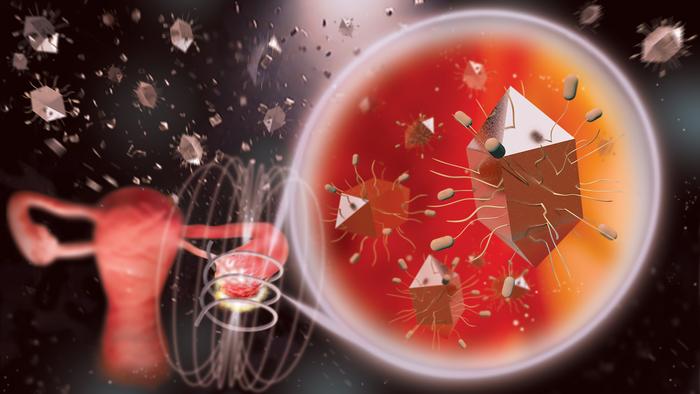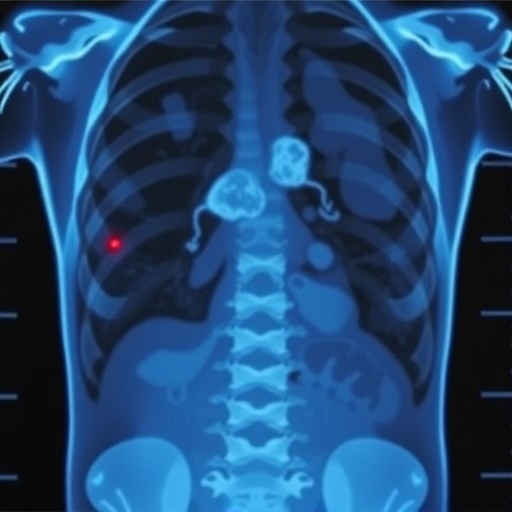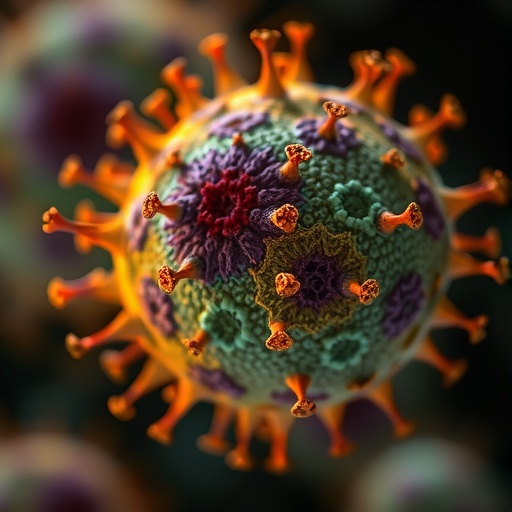In a groundbreaking advancement for cancer treatment, researchers from Oregon State University have engineered a novel type of magnetic nanoparticle designed to revolutionize chemotherapy, particularly for ovarian tumors. These nanoparticles take on a unique shape, resembling a cube sandwiched between two pyramids, reflecting an innovative approach to enhancing the efficacy of magnetic hyperthermia—a treatment that elevates the temperature in and around tumors to combat cancer cells.
This pioneering design is not merely an aesthetic choice; it stems from a carefully thought-out exploration into how the physical dimensions and structures of nanoparticles influence their behavior in biological systems. Existing magnetic nanoparticles have shown promise for cancer treatment, yet they often require direct injection into the tumor site for optimal effectiveness. However, the innovative particles developed by this team show the potential to work systemically after being administered intravenously, marking a significant step forward in making treatments more accessible and less invasive.
The cylindrical core of these nanoparticles is composed of iron oxide and is doped with cobalt—an additive that modifies their properties to optimize heating efficiency. Upon exposure to an alternating magnetic field, these engineered particles heat up rapidly, reaching clinically effective temperatures necessary for damaging and potentially eliminating cancer cells. Specifically, the particles can increase tissue temperatures by an impressive 3.73 degrees Celsius per second, a figure that doubles the performance of previous cobalt-doped nanoparticles crafted by the research team.
The therapeutic heating typically required to destroy cancer cells exceeds 44 degrees Celsius. Previous magnetic nanoparticles have struggled to achieve these conditions without direct injection. The researchers emphasize that their creation does not just meet this requirement; it exceeds it by heating tumors to temperatures beyond 50 degrees Celsius, allowing for a broader range of applications of magnetic hyperthermia across various hard-to-reach tumors.
Throughout their research, the scientists employed a novel two-step thermal decomposition method, referred to as the seed and growth approach, which facilitates the consistent production of these unique cubical bipyramidal nanoparticles. This method distinguishes its design from all previous attempts in nanoparticle construction, thus enhancing the degree of thermal efficiency achieved during cancer treatments.
Interestingly, the integration of a cancer-targeting peptide into the nanoparticle design significantly contributes to the particles’ capacity to localize within tumors. This mechanism not only improves the therapeutic impact of the heating but also means that a lower dosage can be used to achieve the necessary concentration within the tumor, subsequently reducing potential toxicity and side effects experienced by patients.
This pioneering study was conducted through rigorous testing on mouse models, demonstrating the potential efficacy of these nanoparticles in a living biological system. The mice received intravenous injections, and subsequent applications of the non-invasive magnetic field showcased the nanoparticles’ ability to halt tumor growth effectively. This achievement promises not only improved patient outcomes but also enhances overall patient comfort due to shorter treatment sessions, making the protocol more palatable for those undergoing cancer therapies.
Furthermore, the findings were published in the prestigious journal Advanced Functional Materials, underlining their relevance to current and future applications in the field of nanomedicine. The collaborative efforts of scientists from various institutions, including Oregon Health & Sciences University and the Indian Institute of Technology Mandi, speak to the study’s comprehensive scope and its potential impact on interdisciplinary cancer research moving forward.
The researchers are optimistic about the implications of their work, stating that, with these new nanoparticles, patients with challenging-to-treat tumors may soon have access to effective therapeutic options that previously seemed impractical. They envision expanded applications of their magnetic hyperthermia techniques that could extend beyond ovarian cancer into treating other forms of malignancies, fostering new hope in cancer therapy landscapes.
Moreover, this breakthrough aligns with a growing trend in medicine—strategically engineering nanomaterials that can interact intelligently with biological systems. The potential of magnetic nanoparticles in cancer treatment exemplifies how advances in materials science can converge with medical applications, heralding a new age of medicine where targeted treatments could significantly alter the course of patient outcomes.
This innovative research is emblematic of the promising future that lies in the intersection of technology and medicine, revealing how finely-tuned material properties—even at the nanoscale—can engender transformative health solutions. As researchers continue to explore the myriad possibilities inherent in engineered nanoparticles, we may soon witness a shift in cancer treatment paradigms, empowering patients with more effective, accessible, and less invasive therapeutic options.
Through their ongoing work, these pioneers in nanomedicine are not merely pushing the envelope of scientific inquiry; they are reshaping the trajectory of cancer treatment, ensuring that patients may have a fighting chance in their battle against this pervasive illness.
Subject of Research: Animals
Article Title: Precision-Engineered Cobalt-Doped Iron Oxide Nanoparticles: From Octahedron Seeds to Cubical Bipyramids for Enhanced Magnetic Hyperthermia
News Publication Date: 16-Mar-2025
Web References: Advanced Functional Materials
References: DOI 10.1002/adfm.202414719
Image Credits: Parinaz Ghanbari
Keywords: Magnetic Nanoparticles, Cobalt-Doped Iron Oxide, Cancer Treatment, Hyperthermia, Nanomedicine, Tumor Therapy, Engineered Nanoparticles.
Tags: chemotherapy advancements with nanoparticlesenhancing efficacy of cancer treatmentsinnovative designs in nanoparticle engineeringiron oxide and cobalt in nanoparticlesless invasive cancer therapiesmagnetic hyperthermia for ovarian tumorsnanoparticles for cancer treatmentnovel magnetic nanoparticlesovarian tumor progression inhibitionsystemic administration of nanoparticlestargeted cancer cell destruction techniquestemperature elevation in cancer therapy





